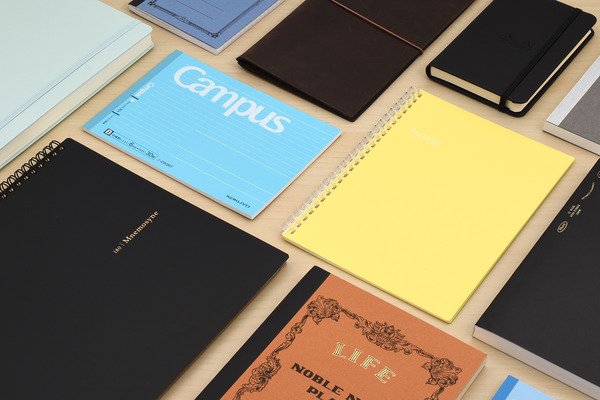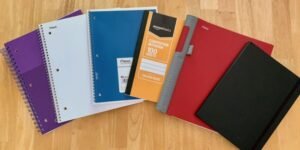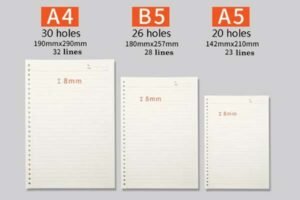
Are you feeling lost in the world of notebooks? Choosing the wrong one can disrupt your workflow or fail to represent your brand. Understanding the basic types is the key.
A notebook is defined by its binding, cover, inner pages1, size, purpose, and special features. These categories help you break down any notebook to its core parts and build the perfect one.
These classifications are more than just labels. They are the building blocks we use at NotebookRing® to create a truly custom product. Since 2006, we've helped clients navigate these options to design notebooks that perfectly match their needs. Whether for a German bookstore or a Silicon Valley tech company, the process starts with understanding these fundamentals. A notebook is a personal and professional tool, and every detail contributes to its function and feel.
In this guide, we will walk you through the six main ways to classify notebooks. We will look at how the binding changes usability. We will explore different cover materials and styles. We will discuss what makes inner pages right for a specific task. We will also cover purpose, size, and other unique features that can make a notebook stand out. This will help you make a better choice for your next project.
How Does Binding Method Define a Notebook?
The way a notebook is held together is very important. It affects how the notebook lays on a desk and how long it lasts. Let's look at the main options.
The most common binding methods2 are spiral binding, sewn binding, and ring binders. Spiral coils allow the notebook to fold back on itself, sewn spines offer a classic book feel, and ring binders let you add or remove pages.

Choosing the right binding is about balancing flexibility, durability, and aesthetics. Each method serves a different primary function. For example, a student might prefer a sturdy spiral notebook, while a professional might want an elegant sewn journal. At our facility, we have perfected these methods to meet specific client needs.
Common Binding Methods We Offer
We have developed expertise in several key binding types to offer our clients maximum flexibility.
| Binding Method | Key Feature | Best For | Our Advantage |
|---|---|---|---|
| Sewn Glue Binding | Pages are sewn in sections, then glued. | Journals, premium notebooks, thin planners. | We can achieve ultra-thin binding for planners up to 200 pages, a challenge for many suppliers. |
| Metal Coil/Spiral | A wire coil runs through punched holes. | Student notebooks, manuals, sketchbooks. | We have a patented "seamless coil" technology that provides a 360° smooth touch and won't snag on clothes. |
| Ring Binder System | Metal rings open to add or remove pages. | Planners, corporate systems, refillable journals. | Our binders adapt to international standards like Filofax, Campus, and Kokuyo, using rust-proof 304 stainless steel. |
A Special Case: 180° Flat-Lay Design
For a German chain bookstore, we developed a notebook series with a bare spine binding. This method exposes the sewn signatures of the book, which allows it to lay completely flat at 180 degrees. This is perfect for drawing or writing across two pages. It is a great example of how a traditional technique can solve a modern design problem.
What Are the Options for Notebook Covers and Styles?
The cover is the first impression of your notebook. It provides protection for the pages inside and is a canvas for your brand identity.
Notebook covers come in materials like PU leather, paperboard, cloth, or even sustainable fibers. You can customize them with techniques like hot stamping, laser engraving, or embossing to create a unique look.

The cover style sets the tone. A simple, embossed logo on a hardcover creates a professional feel for corporate gifts. A colorful design on a flexible cover might be better for a creative journal. We work with clients to match the cover material and customization to their brand's message. Our goal is to make the outside as thoughtful as the inside.
Cover Customization Techniques
Adding a logo or design to a cover elevates it from a simple notebook to a branded item. Here are some of our most popular options.
| Technique | Description | Ideal For | Price Add-on (per unit) |
|---|---|---|---|
| Hot Stamping | A metallic foil is pressed onto the cover. | Elegant logos, premium branding. | $0.08 |
| Laser Engraving | A laser etches a design into the material. | Intricate designs on metal or leather. | $0.12 |
| Embossing | A design is pressed into the cover for a 3D effect. | Subtle, tactile logos and patterns. | $0.15 |
Eco-Friendly Cover Materials
We are always exploring new, sustainable materials. We offer covers made from bagasse fiber, which is a byproduct of sugarcane processing. We also have options for degradable PP plastic covers. These choices allow our clients to create high-quality products while meeting environmental standards.
How Do Inner Pages Change a Notebook's Function?
The paper inside a notebook is where your work happens. The right paper and page layout can significantly improve the writing or drawing experience.
Inner pages are defined by paper weight (GSM), paper type (e.g., acid-free, recycled), and format (e.g., lined, grid, dot, blank). These elements determine how the notebook feels and functions.

Think about how you will use the notebook. An artist using ink needs thick paper that prevents bleed-through. A writer might prefer a smooth, lightweight paper. We guide clients through these choices to ensure the final product is a pleasure to use. For example, upgrading from standard 80gsm paper to a thicker 100gsm paper costs just $0.07 per book and makes a big difference in quality.
Paper Selection Matters
- Paper Weight: Measured in grams per square meter (gsm), this affects the paper's thickness and opacity. We offer a range from 80gsm to 120gsm to suit pens, markers, and pencils.
- Paper Type: We stock a variety of papers, including acid-free paper for longevity, FSC-certified recycled paper at no extra cost, and premium options like Japanese Tomoe River paper.
- Page Formatting: Your notebook, your rules. We can print standard lines, grids, or dots. We can also create completely custom layouts with page numbers, logos, or bilingual text to serve specific markets, like the German/English notebooks we produce for our clients.
Custom Add-Ons
For a Japanese stationery brand, we developed a notebook especially for washi tape enthusiasts. The inner pages had a pre-cut dotted line, making it easy to tear out sections cleanly. This small feature turned the notebook into a bestseller. It shows how a simple customization can meet a very specific user need.
How Do You Choose a Notebook Based on Its Purpose?
A notebook should be a tool built for a specific job. A notebook for a student has different needs than one for a corporate executive or a designer.
Notebooks are often designed for a specific purpose. This could be for education, corporate gifting, or creative projects. Each purpose guides decisions on durability, style, and features.
We create industry-specific solutions by combining the right elements. We listen to what our clients need the notebook to do. Then, we build it from the ground up. This approach helps solve common pain points for our customers, whether they need small batches or highly specialized features.
Industry-Specific Solutions
- For Educational Institutions: We produce bulk orders of notebooks for schools. These often feature tear-proof reinforced binding to withstand heavy use and custom inner pages with things like subject dividers.
- For Corporate Gifting: We helped a corporate gift company in Singapore that struggled to find suppliers for small-batch orders. We created a set of 300 notebooks with a laser-engraved company logo, solving their problem and providing a high-end gift.
- For Creative Industries: A designer in Japan needed an ultra-thin weekly planner that was less than 8mm thick but still had over 200 pages. We used our specialized sewn-binding process to meet this exact specification.
What Are the Standard Notebook Sizes?
The size of a notebook affects its portability and how much space you have to write. Choosing the correct size is a simple but important decision.
Common notebook sizes include A5 (the all-rounder), B6 (for portability), and larger A4 (for desktops). We also create custom and special-shaped notebooks to fit any need, including small passport sizes.
While standard sizes are popular for a reason, we believe a notebook should fit your project perfectly. That is why we offer custom sizing. We can produce notebooks in standard international sizes or create a unique dimension just for you.
A Quick Guide to Notebook Sizes
| Size | Approx. Dimensions (inches) | Best For |
|---|---|---|
| A4 | 8.3 x 11.7 in | Desks, extensive notes, schoolwork |
| A5 | 5.8 x 8.3 in | General journaling, meeting notes, daily planning |
| B6 | 4.9 x 6.9 in | Portable planning, travel journals |
| Passport | 3.5 x 4.9 in | Quick notes, pocket carry |
What Special Features Can Make a Notebook Unique?
Small details can transform a standard notebook into a unique and highly functional tool. These features add convenience and a touch of personality.
Special features elevate a notebook's design. These can include a 180° flat-lay binding, perforated pages for easy tearing, an elastic closure, a pen loop, or compatibility with planner systems.
When we design a notebook, we think about the entire user experience. How will it be carried? What will it be used with? Answering these questions helps us recommend features that add real value. For example, ensuring our ring binders are compatible with popular systems like Filofax means our clients can reach a wider audience of planner enthusiasts.
Functional and Aesthetic Enhancements
- 180° Flat-Lay Binding: Perfect for artists and designers.
- Perforated Pages: Ideal for sharing notes or making clean lists.
- Elastic Closures & Pen Loops: Keep your notebook secure and your pen handy.
- Rounded Corners: A small touch that prevents bent corners and adds a polished look.
- Tear-Proof Reinforcement: Adds durability for notebooks that see heavy daily use.
Conclusion
Notebooks are classified by binding, cover, pages, purpose, size, and features. Knowing these options allows you to work with us to design a custom notebook that is perfectly suited for your brand, your customers, and any project you can imagine.





